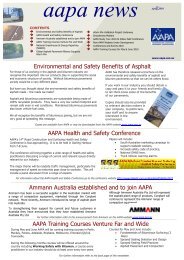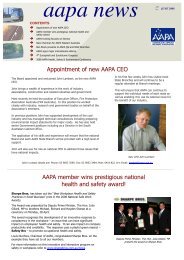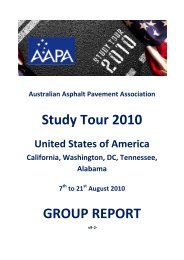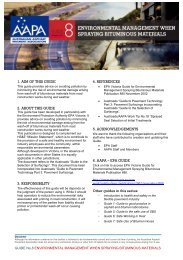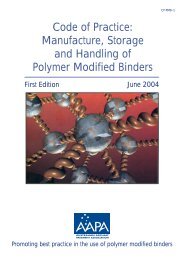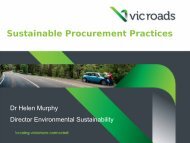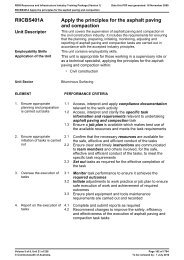performance assessment of paving - Australian Asphalt Pavement ...
performance assessment of paving - Australian Asphalt Pavement ...
performance assessment of paving - Australian Asphalt Pavement ...
Create successful ePaper yourself
Turn your PDF publications into a flip-book with our unique Google optimized e-Paper software.
<strong>Pavement</strong> ConditionsCondition <strong>of</strong> pavements where <strong>paving</strong> fabrics can be utilised, along with required pre-treatments,are tabled below.Table 1. <strong>Pavement</strong> conditions – remarks for <strong>paving</strong> fabric interlayersType <strong>of</strong> DistressSurfacing CracksBlock / Stabilisation CracksLongitudinal or Transverse CracksCrocodile CrackingPumpingRuttingPotholesPatchesEdge BreakingRemarksCracks > 7 mm wide to be pre-filled.Cracks > 7 mm wide to be pre-filled.Cracks > 7 mm wide to be pre-filled.Cracks > 7 mm wide to be pre-filled.Cracks > 7 mm wide to be pre-filled.Pre-treatment with levelling layer.Potholes to be repaired or pre-filled.Distressed, broken patches to be pre-filled.Severe edge breaks pre-filled or repairedTypical Issues with Paving FabricsGeneralCutback bitumen’s should be avoided. If the climate conditions require a cutter to be addedto the bitumen, it is preferable that the tack coat placed prior to placement <strong>of</strong> the <strong>paving</strong> fabric isnot cut back. Minimising the use <strong>of</strong> the cutter prevents it being locked in the fabric, leaving thevolatiles try to escape/evaporate during hot weather, causing s<strong>of</strong>tening <strong>of</strong> the bitumen. This resultsin bleeding, slippage <strong>of</strong> the wearing course on the <strong>paving</strong> fabric and loss <strong>of</strong> aggregate. GradeC170 is commonly used and provides adequate adhesion for <strong>paving</strong> fabric.Delamination• Water in base course - sub soil drainage may be required• Insufficient tack coat and/or saturation <strong>of</strong> <strong>paving</strong> fabric (allowing water ingress)• Laying <strong>paving</strong> fabric in wet conditions• Insufficient bond coat to overlap <strong>of</strong> fabricMechanical failures• Vertical crack movement is excessive – fabric elongation excessive (cracks too large)• Insufficient/lack <strong>of</strong> overlap in full width applications• Laid in lanes and at intersections where braking load is excessive• Holes and cracks larger than 7 mm not being repaired or pre-filled• Existing rough surface (asphalt levelling course required prior to <strong>paving</strong> fabric placement)Shoving / heaving• At intersections or sharp or high speed bends• Slippage on old bleeding surfaceBleeding (spray seals)• Too much bond coat to fabric• Too much binder coat to stone• Use <strong>of</strong> cutback bitumens
Paving Fabric PropertiesThe <strong>Australian</strong> installations <strong>of</strong> <strong>paving</strong> fabric for maintenance re-seals has typically used a 140 gsmPolyester non-woven needle punched geotextile with a melting point in excess <strong>of</strong> 240°C. Typicalproperties are shown in table 2.MassThicknessWide Strip TensileMD/XMDWide Strip ElongationMD/XMDTrapezoidal TearMD/XMDAS3706.1AS3706.1AS3706.2AS3706.2AS3706.3g/sqmmmkN/mMARVTypicalMARVTypicalMARVTypical% MARVTypicalkNMARVTypical1391471.431.588.9/7.410.6/9.042/5255/65245/215290/2551842001.862.0913.9/10.516.3/12.547/5657/67305/280412/348Minimum Melt Temp. - Degrees C 240 240Bitumen Retention @160 degºCTable 2. Paving Fabric PropertiesCost ConsiderationsASTM D6140 litres/sqm Typical 1.0 1.4Paving fabric used in reseal rehabilitation and maintenance construction is regularly specified eachyear as part <strong>of</strong> the annual reseal contracts in South Australia, Victoria, New South Wales andQueensland. Sprayed seal applications <strong>of</strong> the standard 140 gsm <strong>paving</strong> fabric reseal is generallycosted at around $7.50/sqm, a traditional reseal costing in the order <strong>of</strong> $5.00/sqm.Heavier 180 gsm <strong>paving</strong> fabrics designed for low traffic roads laid on existing clay base courseswere the basis <strong>of</strong> the trials in New South Wales at Brewarrina using the ALF apparatus, whichproved the worth <strong>of</strong> <strong>paving</strong> fabrics, with the cost in 1991 for normal reconstruction <strong>of</strong> a 300mmsealed pavement costing $100,000/km compared with a simple geotextile reseal over suitableinsitu material at $65,000/km.<strong>Asphalt</strong> seals are generally a minimum <strong>of</strong> 40mm thickness, with <strong>paving</strong> fabric adding to the overalllaid rate cost around $2.00/sqm.Life Cycle ConsiderationsLife cycle costing applies more to maintenance reseal programs, where the real consideration forincorporating a 140g <strong>paving</strong> fabric into a seal design is what benefit the additional 7-8 year life willgive, when the whole surfacing life span extends to the predicted 15 years with a <strong>paving</strong> fabricinterlayer.Spray Seals;Paving fabric incorporated into a sprayed seal will cost roughly the same amount as a standardreseal for invested or borrowed funds over the expected standard pavement 8 year life, as theinvestment <strong>of</strong> additional funds required for a <strong>paving</strong> fabric seal will equal the investment <strong>of</strong> twostandard seals over a 15 year life, but provide for a once only application in 15 years.
<strong>Asphalt</strong>;Paving fabric incorporated into an asphalt overlay will cost an additional 10% over the cost <strong>of</strong> a50mm thick asphalt overlay designed for a 10 year life; however the additional investment requiredfor a <strong>paving</strong> fabric will provide a 50% increase in life span for a once only application in 15 years.UTA incorporating <strong>paving</strong> fabric as a SAMI has been selected where matching adjacent road lineand levels is necessary, with cost savings in no requirements for milling and planning. Thisapplication has been in place for at least 10 years in SA and Vic where <strong>performance</strong> is proving thatthis treatment is at least equivalent to deeper asphalt layers to date.Therefore the extension <strong>of</strong> pavement life provides;1. Choice <strong>of</strong> a cost effective alternative treatment2. Longer maintenance time frames3. Revision <strong>of</strong> maintenance planning4. Savings through less frequent maintenance and traffic disruption5. Allowance for priorities to other roads in a network6. Safety through the provision <strong>of</strong> more stable and skid resistant surfaces7. Provision <strong>of</strong> asset investment choice8. Management <strong>of</strong> the political aspects <strong>of</strong> assets.DesignSeal design with <strong>paving</strong> fabrics is similar to normal seal design, except that an allowance is madefor the bitumen absorption <strong>of</strong> the <strong>paving</strong> fabric in the total bitumen requirement. Design shouldconsider the appropriate allowances for existing surface texture, traffic count, vehicle mass orESA’s and prevailing pavement temperature. The use <strong>of</strong> an adhesion agent/additive isrecommended.Spray Seals;The design <strong>of</strong> the <strong>paving</strong> fabric seal requires the following consideration;1. Obtain <strong>paving</strong> fabric absorption rate from manufacturer2. Determine existing surface texture and allowance for voids3. Design the seal application rate4. Determine the total application rate5. Determine bond coat application rate (<strong>paving</strong> fabric to existing surface)6. Determine binder application rates from total rate for;- first seal coat application rate- second seal coat application rate.Typical bitumen application rates;- Bond coat; 0.6 – 0.9 litres/sqm- First seal coat; 0.9 – 1.1 litres/sqm (14mm stone)- Second seal coat; 0.7 – 0.9 litres/sqm (7mm stone)<strong>Asphalt</strong>;Key to the reinforcement based design <strong>of</strong> <strong>paving</strong> fabrics in reflective crack prevention is the fabricseffectiveness, determined by laboratory testing and confirmed by experience. Koerner 1 states thatthe Fabric Effectiveness Factor (FEF) is determined by the number <strong>of</strong> load cycles to cause failurein a non-reinforced asphalt overlay case, divided into the number <strong>of</strong> load cycles to cause failure ina geotextile reinforced asphalt overlay case.Laboratory testing by Murray 2 found that a non woven needle punched polyester <strong>paving</strong> fabricyielded a FEF <strong>of</strong> approx. 4.8. Koerner has in his design methodology adopted a figure <strong>of</strong> 3 anduses a control without geotextile, <strong>of</strong> 1.0.The US <strong>Asphalt</strong> Institutes’ <strong>Asphalt</strong> Overlays and <strong>Pavement</strong> Rehabilitation manual MS-17 outlinesthe design procedure for calculation <strong>of</strong> pavement and asphalt overlay thickness. Multiplying the
Case Studies – Sprayed SealsA cross section <strong>of</strong> older projects is reviewed in the following pages. All projects have been recentlyevaluated in 2009 with assistance and comments provided from asset owners, on projects rangingfrom 10 years up to 19 years in age.RN 7200 Sturt Hwy – Accommodation HillLocation;MM90.9 – MM98 Truro-BlanchetownAsset Owner; DTEI South AustraliaResealed; 1996AADT; 3800Stone;14/5mmPaving Fabric; Sealmac PF1Bond coat;C170Binder Type; S35E/C170Application Rates; 0.8/1.45/0.75Existing condition; <strong>Pavement</strong> shape and strength good despite poor existing surface conditionSmall crazing and continuous block cracking, pavement pumping severely.<strong>Pavement</strong> 1996 - Approx location MM91 Laying PF1<strong>Pavement</strong> 1996 - Approx location MM91 – Laying PF1
Review 2009; Good general condition, Holding together well despite some pumping occurring.Some stone smoothing evident. Ongoing rehabilitation on various sections <strong>of</strong> the Sturt Hwy hasincorporated PF1 <strong>paving</strong> fabric since 1996. Sections not treated in the past with <strong>paving</strong> fabricrequire treatment, with <strong>paving</strong> fabric proposed.<strong>Pavement</strong> 2009 - MM 93 looking west<strong>Pavement</strong> 2009 - MM 93 looking west
<strong>Pavement</strong> 2009 - MM 93. Some pumping occurring in wheel path<strong>Pavement</strong> 2009 - MM 93. Wheel path showing tight interlock, good bond and wear.RN 8400 Jubilee Hwy – Mt GambierLocation;MM349 – MM354Asset Owner; DTEI South AustraliaResealed; 1996AADT;7100 (logging traffic)Stone;16/7mmPaving Fabric; Sealmac PF1Bond coat;C170Binder Type; S15E/C170Application Rates; 0.8/1.3/0.9l/sqmAir Temp; 30 deg C.Area;32,000 sqm
Existing condition; severe fatigue cracking and some environmental crack component.Load induced failure occurring from high curvature alignment and high commercial vehicle count.<strong>Pavement</strong> failing in wheel paths and could not take loads, however no funds available formandatory reconstruction.Sealing 1996; Paving fabric application to outer lane where heavier traffic loads occur. Spray ratedesigned for heavy logging traffic, resulting in low application rates to combat potential forbleeding. 8 lane km’s laid, being the longest application to date <strong>of</strong> <strong>paving</strong> fabric in S.A.<strong>Pavement</strong> 1996 - MM 349. Laying PF1<strong>Pavement</strong> 1996 - MM 349. Laying 7mm stone
Review 2009; Good general condition, holding together well despite the heavy loads. Somereflective cracking around culvert crossings.Road now considered beyond another spray seal, however due to regional location rendering theapplication <strong>of</strong> asphalt not practical. Road rehabilitated with <strong>paving</strong> fabric PF1 two coat reseals as<strong>of</strong> 2009. Jubilee Hwy has had ongoing staged applications <strong>of</strong> <strong>paving</strong> fabric since 1996, for its entirelength <strong>of</strong> 6 km.<strong>Pavement</strong> 2009 - MM 349 looking west<strong>Pavement</strong> 2009 - MM 349. <strong>Pavement</strong> looking west
<strong>Pavement</strong> 2009 - MM 349 pavement on wheel pathSurface in good condition despite some stone wearBendigo – Sutton Grange RoadLocation;South <strong>of</strong> BendigoAsset Owner; VicRoadsSealed; 1996AADT; 500Stone;14/7mmPaving Fabric; Sealmac PF1Bond coat;C170Binder Type; S35E/C170Area;~5,600 sqmExisting condition; severe surface degradation and horizontal cracking. Road required completerehabilitation, however reconstruction was limited because <strong>of</strong> narrow road width and closeproximity <strong>of</strong> trees and property. Nominal 30mm asphalt regulation layer was placed before sealing.Existing road 1996
2009 <strong>assessment</strong>; Surface condition excellent, blemish free, can last another few years. Road hasbeen highly trafficked with very heavy loads over 18 months in 2008/09 with Calder Hwyconstruction traffic.<strong>Pavement</strong> 2009<strong>Pavement</strong> 2009 - Paving fabric at edge <strong>of</strong> sealSeal appears in good condition, little stone wear. Paving fabric providing edge stability.
Princes Hwy - UlladullaLocation;30 km south <strong>of</strong> UlladullaAsset Owner; RTASealed; 2004AADT; 4000Stone;14/7mmPaving Fabric; Sealmac PF1Application Rates; 0.6/1.8/0.6Bond coat;C170Binder Type; S35E/C170Area;>135,000 sqmExisting condition; Stabilised pavement block cracking. Total rehabilitation only option to use <strong>of</strong><strong>paving</strong> fabric.<strong>Pavement</strong> spray seal application 2004<strong>Pavement</strong> 2004
<strong>Pavement</strong> 2009<strong>Pavement</strong> Trial – Appila South AustraliaLocation;1km – 2kmAsset Owner; DTEI South AustraliaSealed; 1990AADT; 300Stone;14mm Single SealPaving Fabric; Sealmac PF2 (180 gsm)Bond coat;C170Binder Type; C170 (5% adhesion additive)Application Rates; 0.8/1.45/0.75Existing condition; Existing low strength sub-base, 150mm weak rubble base course laid 1990.Sealing 1990; Trial was instigated to establish viability <strong>of</strong> geotextile reinforced seals on low volumeroads that enable construction with no or little road reconstruction requirement. The site waschosen because <strong>of</strong> the existing low strength rubble base course and low volume traffic count.<strong>Pavement</strong> 1990 - Existing base course
<strong>Pavement</strong> 1990 - Laying <strong>paving</strong> fabricReview 1997; Good general condition, PF2 appears similar to 1990 and holding together welldespite poor drainage. No evidence <strong>of</strong> reflective cracking although adjacent un-reinforced sectionshowed reflective cracking and excessive edge wear.<strong>Pavement</strong> 1997 – pavement comparisonReseal 2009; Original seal holding up well after 19 years. some stone loss and voids have beenrectified with a 7mm seal applied to surface to top up stone pr<strong>of</strong>ile and enrich lost binder to theoriginal single 14mm seal.
Case Studies – <strong>Asphalt</strong> OverlaysA cross section <strong>of</strong> older projects is reviewed in the following pages. All projects have been recentlyevaluated in 2009 with assistance and comments provided from designers and asset owners, onprojects ranging from 10 years up to 15 years in age.University Drive – Flinders UniversityLocation;Sturt, South AustraliaAsset Owner; University <strong>of</strong> South AustraliaSealed; 1999<strong>Asphalt</strong>;40mmPaving Fabric; Sealmac PF1Bond coat;C170Area;~20,000 sqmExisting condition; Reflective cracking resulting from environmental factors influencing reactive claysubgrade and substrates.Laying fabric - 1999<strong>Pavement</strong> 2009; Old untreated pavement adjacent University Drive
University Drive 2009;<strong>Pavement</strong> 2009
Vasey StreetLocation;Greenacres, South AustraliaAsset Owner; City Port Adelaide EnfieldSealed; 1996<strong>Asphalt</strong>;30mmPaving Fabric; Sealmac PF1Bond coat;C170Area;4,000 sqmExisting condition; Reflective cracking resulting from environmental factors influencing reactive claysubgrade and substrate. 30mm asphalt resurfacing laid over reconstructed 40mm FCR basecourse, typical construction by the council for this era, for achieving extra strength over reactiveclay subgrade.Sealing 1994<strong>Pavement</strong> 2009
<strong>Pavement</strong> 2009Untreated pavement 2009
Midland HwyLocation;Bendigo VictoriaAsset Owner; VicRoadsSealed; 2007<strong>Asphalt</strong>;15mm UTAPaving Fabric; Sealmac PF1Bond coat;C170Area;~5,000 sqmExisting condition; Poor surface with varied pavement widenings and pavement contruction due tolane widenings. Regulation and patching <strong>of</strong> weaker areas undertaken before resurfacing.With a life expectancy <strong>of</strong> 10 years, UTA surface incorporating a <strong>paving</strong> fabric SAMI was chosen toprovide a quieter surface than sprayed sealing, however, based on economical feasibility, UTAwas an alternative to deeper asphalt, without the problems <strong>of</strong> matching fixed water table levels.Paving fabric SAMI would assist in control <strong>of</strong> reflective cracking from varied pavement constructionand protect from environmental influence.Midland Hwy. Adjacent untreated pavement - 2009
Midland Hwy pavement 2009Murphy StreetLocation;Asset Owner;<strong>Asphalt</strong>;Paving Fabric;Bond coat;Area;Bendigo, VictoriaCity <strong>of</strong> Bendigo14/7 sealSealmac PF1C170~2,000 sqmFailed <strong>paving</strong> fabric seal over cracked slurry seal due to;Existing smooth slurry sealed surfaceHigh braking loads from buses stoppingNo overlap join in the geotextile<strong>Pavement</strong> 2009
ConclusionThe results <strong>of</strong> test sections and installations as detailed in the above case studies in SouthAustralia and Victoria over the last 19 years has shown that geotextile seals can enhance theprincipal functions <strong>of</strong> conventional surfacings to extend the field <strong>of</strong> application <strong>of</strong> commonlyspecified seals. Many more <strong>paving</strong> fabric applications exist also in Queensland and New SouthWales that are achieving life spans over 15 years, cases that are currently under review with roadauthorities design and site construction personnel.Considering the above case studies and taking account <strong>of</strong> the vast area <strong>of</strong> application <strong>of</strong> <strong>paving</strong>fabric over the last 20 years, evidence <strong>of</strong> <strong>paving</strong> fabrics extending the life <strong>of</strong> surfacings by up to 10years above the design life <strong>of</strong> 8-10 years has been shown to provide real benefits to life cyclecostings <strong>of</strong> seals. For the additional cost, the benefit to maintenance programs by either catchingup on lost time, or delaying the application <strong>of</strong> a reseal to twice the time frame normally allocated, isvery real in terms <strong>of</strong> not only time, but economics.The evidence <strong>of</strong> <strong>performance</strong> presented can allow road engineers to embrace a broader scope <strong>of</strong>existing conditions where seals can out perform traditional methods for similar existing surfacefailures. There is also increasing awareness that the cost benefits are evident as the <strong>paving</strong> fabrictreated surfaces show their strength and longevity in outlasting conventional seals.Paving fabrics have the ability to provide a water pro<strong>of</strong> interlayer in a spray seal to enhance thestrength and life span <strong>of</strong> a pavement. Reflective cracking is retarded and contained by <strong>paving</strong>fabric providing an effective stress alleviating and waterpro<strong>of</strong>ing membrane over a boundpavement. Non woven needle punched geotextiles provide, because <strong>of</strong> their construction, a threedimensional bitumen reservoir for optimum bitumen absorption and tensile strength to act in astress alleviating function. Ensuring the correct <strong>performance</strong> <strong>of</strong> <strong>paving</strong> fabrics is achieved,installation with proper procedures and application with correctly determined spray rates isessential.Comments over this evaluation period in 2009 include remarks <strong>of</strong> ‘we are expecting more andmore <strong>of</strong> <strong>paving</strong> fabrics’, ‘we are selecting <strong>paving</strong> fabric where there are no other options wouldwork’ and we are selecting <strong>paving</strong> fabrics where cost prohibits mandatory pavement rehabilitation’.Opinions <strong>of</strong>fered also, included the selection <strong>of</strong> <strong>paving</strong> fabric in asphalt to extend pavement life andusing <strong>paving</strong> fabrics help restore roads to a normal maintenance cycle.Conclusions were also drawn that <strong>paving</strong> fabrics were selected where road surface condition hadpassed the point <strong>of</strong> conventional reseal considerations, where normal spray seal applicationswould last only 7-8 years, or fibre reinforced or rubber additive options. As shown in the casestudies examined, <strong>paving</strong> fabrics were selected to maintain and extend the design surfacing lifewhere the road would otherwise require total rehabilitation.The eight projects reviewed in this paper are preliminary to an independent evaluation by the<strong>Australian</strong> Road Research board, commissioned by Ge<strong>of</strong>abrics, to assess the applications <strong>of</strong><strong>paving</strong> fabric and report on their current <strong>performance</strong>.AcknowledgementsThe author would like to acknowledge the assistance <strong>of</strong> personnel from Department <strong>of</strong> Transport,Energy and Infrastructure, South Australia, RTA New South Wales and VicRoads, Victoria, insourcing the information to compile this paper.
ReferencesG.M. James, Geosynthetic Materials as <strong>Asphalt</strong> Reinforcement Interlayers: The Southern AfricanExperience. Proceedings <strong>of</strong> the 8th Conference on <strong>Asphalt</strong> <strong>Pavement</strong>s for Southern Africa(CAPSA'04)Murray C.D. Simulation Testing <strong>of</strong> Geotextile Membranes for Reflection Cracking, Proceedings <strong>of</strong>2 nd International Conference on Geotextiles 1982Geotextiles used to Extend the Life <strong>of</strong> Thin <strong>Asphalt</strong> <strong>Pavement</strong>s, Alexander W, McKenna R.Koerner R. Designing with Geosynthetics 5th EditionQld Government, Paving Geotextiles in <strong>Asphalt</strong> and Sprayed Seal Surfacings, Issue No. 8Department <strong>of</strong> Transport, Energy and Infrastructure, South Australia. Resealing RecordsVicRoads, North Western Branch, Bendigo, Victoria. Resealing RecordsBrewarrina ALF (Accelerated Loading Facility) Trial Report 1991, RTA NSW, Australia.City <strong>of</strong> Port Adelaide Enfield, South Australia.Biography:The author is currently employed as Business Development Manager for Geotextiles andDrainage, Ge<strong>of</strong>abrics A/Asia, suppliers <strong>of</strong> drainage products, ground stabilisation and <strong>paving</strong>fabrics to the civil engineering industry. Rod Fyfe has over 14 years experience with <strong>paving</strong> fabricapplications with Ge<strong>of</strong>abrics Australasia as previous State Manager for South Australia andNorthern Territory.Past experience includes the position <strong>of</strong> Contracts Administrator and Estimator with constructioncontractor Stockport Civil, five years designing civil projects with Kinhill Engineers, one year withthe Corporation <strong>of</strong> City <strong>of</strong> Adelaide after commencing a career in civil engineering with theDepartment <strong>of</strong> Main Roads Bridge Section, Tasmania, over the preceding seven year period.Address;Email;Ge<strong>of</strong>abrics A/Asia Pty Ltd1 Marion StreetMelrose Park SA 5039Ph. 08 8177 2055r.fyfe@ge<strong>of</strong>abrics.com.au



